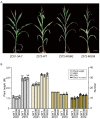Expediting Next-Generation Hybrid Technology in Recalcitrant Maize Inbreds through In Vivo Targeted Activity of CRISPR/Cas9
- PMID: 38892019
- PMCID: PMC11172070
- DOI: 10.3390/ijms25115832
Expediting Next-Generation Hybrid Technology in Recalcitrant Maize Inbreds through In Vivo Targeted Activity of CRISPR/Cas9
Abstract
The Manipulated Genic Male Sterile Maintainer (MGM) system, a next-generation hybrid seed technology, enables efficient production of sortable seeds from genic male sterile (GMS) lines. However, implementing robust MGM systems in commercial maize inbred lines requires stable transformation, a genotype-specific and laborious process. This study aimed to integrate MGM technology into the commercial maize inbred line Z372, developing both GMS and MGM lines. We utilized the MGM line ZC01-3A-7, which contains the MS26ΔE5 editor T-DNA and MGM T-DNA, previously established in the highly transformable ZC01 recipient plants. Through a combination of crossing and backcrossing with Z372, we targeted the fertility gene Ms26 within the Z372 genome for mutation using the in vivo CRISPR/Cas9 activity within the MS26ΔE5 editor T-DNA construct. This approach facilitated precise editing of the Ms26 locus, minimizing linkage drag associated with the Ms26 mutation. Whole-genome SNP analysis achieved a 98.74% recovery rate for GMS and 96.32% for MGM in the BC2F2 generation. Importantly, the Z372-GMS line with the ms26ΔE5 mutation is non-transgenic, avoiding linkage drag and demonstrating production readiness. This study represents a significant advancement in maize breeding, enabling the rapid generation of GMS and MGM lines for efficient hybrid seed production.
Keywords: CRISPR/Cas9; Zea mays L.; genic male sterile; molecular breeding; next-generation hybrid technology.
Conflict of interest statement
The authors declare no conflicts of interest.
Figures






Similar articles
-
Genome Editing Enables Next-Generation Hybrid Seed Production Technology.Mol Plant. 2020 Sep 7;13(9):1262-1269. doi: 10.1016/j.molp.2020.06.003. Epub 2020 Jul 8. Mol Plant. 2020. PMID: 32645290
-
Use of CRISPR/Cas9-Based Gene Editing to Simultaneously Mutate Multiple Homologous Genes Required for Pollen Development and Male Fertility in Maize.Cells. 2022 Jan 27;11(3):439. doi: 10.3390/cells11030439. Cells. 2022. PMID: 35159251 Free PMC article.
-
Generation of a new thermo-sensitive genic male sterile rice line by targeted mutagenesis of TMS5 gene through CRISPR/Cas9 system.BMC Plant Biol. 2019 Mar 20;19(1):109. doi: 10.1186/s12870-019-1715-0. BMC Plant Biol. 2019. PMID: 30894127 Free PMC article.
-
Maize Genic Male-Sterility Genes and Their Applications in Hybrid Breeding: Progress and Perspectives.Mol Plant. 2019 Mar 4;12(3):321-342. doi: 10.1016/j.molp.2019.01.014. Epub 2019 Jan 26. Mol Plant. 2019. PMID: 30690174 Review.
-
Exploration and utilization of maize male sterility resources.Yi Chuan. 2022 Feb 20;44(2):134-152. doi: 10.16288/j.yczz.21-327. Yi Chuan. 2022. PMID: 35210215 Review.
References
-
- Horner H.T., Palmer R.G. Mechanisms of genic male sterility. Crop Sci. 1995;35:1527–1535. doi: 10.2135/cropsci1995.0011183X003500060002x. - DOI
-
- Rogers J.S., Edwardson J.R. The utilization of cytoplasmic male-sterile inbreds in the production of corn hybrids. Agron. J. 1952;35:8–13. doi: 10.2134/agronj1952.00021962004400010004x. - DOI
-
- Ullstrup A.J. The impacts of the southern corn leaf blight epidemics of 1970–1971. Annu. Rev. Phytopathol. 1972;10:37–50. doi: 10.1146/annurev.py.10.090172.000345. - DOI
-
- Williams M.E. Genetic engineering for pollination control. Trends Biotechnol. 1995;13:344–349. doi: 10.1016/S0167-7799(00)88979-9. - DOI
MeSH terms
Substances
Grants and funding
LinkOut - more resources
Full Text Sources

